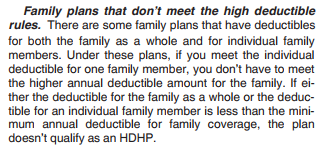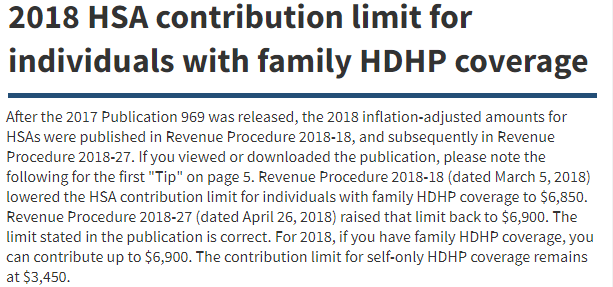Overview
As with many things HSA related, the HDHP (High Deductible Health Plan) definitions are more complicated than they need to be. Each year, the IRS defines what plans are “HSA eligible” meaning those plans allow you to open and contribute to a Health Savings Account. The definition consists of two attributes – Minimum Deductible and Out of Pocket Max. Moreover, these two attributes vary based on the type of coverage you have, which is either self-only or family. Note that even if you get those right and your plan is an HDHP (and by definition, HSA eligible), there are still other requirements that determine your HSA eligibility – this is just the first of 4.
The goal of this article is to explain the HSA Minimum Deductible and the Out of Pocket Max, what they are, their amounts for a given tax year, and go through some examples of how they work and what plans qualify.
Minimum Deductible
All insurance plans have a deductible, or the amount you must pay before insurance kicks in and begins covering expenses for the year. This amount can vary between $0 and many thousands of dollars. To be HSA eligible, a plan must have a deductible greater than or equal to that year’s Minimum Deductible. In essence, it defines the “High” part of High Deductible Health Plan. It says, “if you want to contribute to an HSA, your insurance deductible must be at least this amount”.
The inverse is also true: insurance plans with a deductible less than or equal to the Minimum Deductible are not HSA eligible. If your insurance has an deductible less than the HSA Minimum Deductible, you cannot contribute to an HSA.
HSA eligible plans must have a deductible higher than the minimum deductible
Note that your deductible generally resets at year end. You can use this to your advantage by “taking a bath” in years where you have a lot of medical coverage. If you hit your deductible in a given year, you might as well schedule additional care for that year as insurance has “kicked in” and is paying for your services. If you are close to hitting your deductible, you may want to pull forward expenses from the subsequent year to hit your deductible in the current year. Once the deductible is met, your only financial liability for insurance is 1) premiums and 2) the out of pocket max (discussed next), often driven by “coinsurance”.
Out of Pocket Maximum
All insurance plans have an out of pocket maximum, or the maximum amount that you can spend on medical care in a year. Note that insurance premiums are NOT included in the out of pocket maximum. Instead, it consists of amounts you pay for 1) deductible and 2) coinsurance.
HSA eligible plans must have an out of pocket maximum less than the HDHP definition
To be HSA eligible, your plan cannot exceed the HDHP definition of Out of Pocket maximum. For some reason, the IRS decided that there needed to be an upper bound on OOP max for plans to be HSA eligible. This is counter intuitive, at least to me, as a high out of pocket max is punitive to the holder and costs them more money. It is exactly those people who need the reduced savings HSA provides.
Add it to the list of things to fix : )
If your insurance plan has an out of pocket maximum that exceeds the HDHP definition for a given year, you cannot contribute to an HSA. Also note the risk of coinsurance. Coinsurance is an amount you owe above the deductible. Often times it is stated as a percentage followed by the out of pocket max, for example, 20% up to $10,000. Assuming you have a deductible of $6,000, your plan looks like this:
- Deductible, $6000 – amount you pay before insurance pays anything
- Coinsurance, 20% – after your deductible, percentage of expenses you pay up to your out of pocket max. (For kicks: in this example @ 20% you would require an additional $20k of medical bills, of which you pay $4k in coinsurance, before you reach out of pocket max)/li>
- Out of Pocket Max, $10000 – maximum amount of deductible and coinsurance you can pay in a year.
HDHP Definitions by Year
Below are HDHP definitions by year for your reference:
| 2016 | 2017 | 2018 | 2019 | 2020 | |
| Self-Only Min Deductible | $1,300 | $1,300 | $1,350 | $1,350 | $1,400 |
| Self-Only OOP Max | $6,550 | $6,550 | $6,650 | $6,750 | $6,900 |
| Family Min Deductible | $2,600 | $2,600 | $2,700 | $2,700 | $2,800 |
| Family OOP max | $13,100 | $13,100 | $13,300 | $13,500 | $13,800 |
Examples for plans that qualify as HDHP
Here are some examples of 2020 insurance plans that qualify as an HDHP and allow you to contribute to an HSA:
- Self Only: Deductible = $1,400, Coinsurance = 40%, OOP Max = $6,900
- ✓ Meets minimum deductible; does not exceed out of pocket max.
- Self Only: Deductible = $3,000, Coinsurance = 10%, OOP Max = $4,000
- ✓ Exceeds minimum deductible, does not exceed out of pocket max.
- Self Only: Deductible = $6,700, Coinsurance = 0%, OOP Max = $6,700
- ✓ Exceeds minimum deductible; does not exceed out of pocket max.
- Family: Deductible = $2,800, Coinsurance = 25%, OOP Max = $13,800
- ✓ Meets minimum deductible; does not exceed out of pocket max.
- Family: Deductible = $7,000, Coinsurance = 60%, OOP Max = $10,000
- ✓ Exceeds minimum deductible; does not exceed out of pocket max.
- Family: Deductible = $13,800, Coinsurance = 60%, OOP Max = $13,800
- ✓ Exceeds minimum deductible; meets out of pocket max.
Examples for plans that don’t qualify as HDHP
Here are some examples of 2020 insurance plans that do not qualify as an HDHP and do not allow you to contribute to an HSA:
- Self Only: Deductible = $1,350, Coinsurance = 20%, OOP Max = $6,960
- X Lower than minimum deductible; exceeds out of pocket max.
- Self Only: Deductible = $0 Coinsurance = 40%, OOP Max = $3,000
- X Lower than minimum deductible.
- Self Only: Deductible = $7,000, Coinsurance = 0%, OOP Max = $7,000
- X Exceeds out of pocket max.
- Family: Deductible = $2,700, Coinsurance = 25%, OOP Max = $13,900
- X Lower than minimum deductible; exceeds out of pocket max.
- Family: Deductible = $1,000, Coinsurance = 100%, OOP Max = $5,000
- X Lower than minimum deductible.
- Family: Deductible = $7,000, Coinsurance = 30%, OOP Max = $14,050
- X Exceeds out of pocket max.
Note: I created TrackHSA.com to track medical expenses you pay using Health Savings Account as you spend up to your deductible or out of pocket max. It provides record keeping to store purchases, upload receipts, and record reimbursements securely online.




